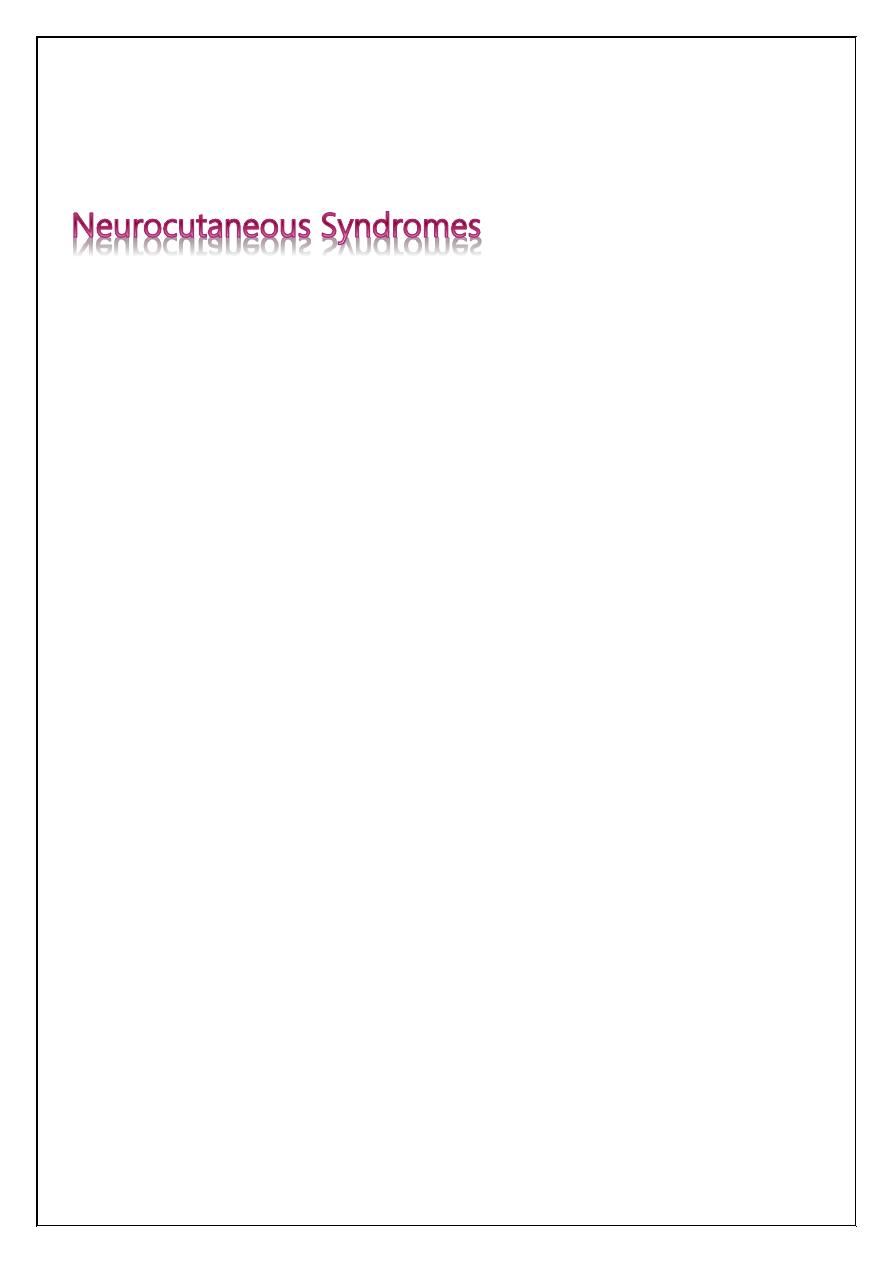
Pediatrics
NEUROLOGY
1
L.5 Dr.Roua Al yaseen
The neurocutaneous syndromes include a heterogeneous group
of disorders characterized by abnormalities of both the skin and
central nervous system (CNS).
These syndromes include:
Neurofibromatosis
Tuberous sclerosis
Sturge-Weber disease
Neurofibromatosis (NF)
NF is a common autosomal dominant disorder.
Clinical manifestations and Diagnosis:
There are two forms of NF:
NF-1: is the most prevalent type (90%).The NF-1 gene located on
chromosome region 17q11. It is diagnosed when any two of the following
seven signs are present:
1- Six or more caféau-lait spots over 5 mm in diameter in prepubertal
individuals and over 15 mm in greatest diameter in postpubertal
individuals. Café au-lait spots are the hallmark of neurofibromatosis and
are present in almost 100% of patients.
They are present at birth but increase in size, number, and pigmentation,
especially during the 1st few years of life.
The spots are scattered over the body surface, mainly the trunk and
extremities, and with sparing of the face.

Pediatrics
NEUROLOGY
2
2- Axillary or inguinal freckling consisting of multiple hyperpigmented areas
2–3 mm in diameter.
3- Two or more iris Lisch nodules Lisch nodules are hamartomas located
within the iris and are best identified by a slit-lamp examination.
They are present in >74% of patients with NF-1.
4- Two or more neurofibromas or one plexiform neurofibroma. Neurofibromas
typically involve the skin, but they may be situated along peripheral nerves
appear characteristically during adolescence
5- A distinctive osseous lesion such as sphenoid dysplasia (which may cause
exophthalmos) or Scoliosis.
6-Optic gliomas are present in ≈15% of patients . ≈20% have visual
disturbances .
7-A first-degree relative with NF-1.
Children with NF-1 are susceptible to:-
1.Neurologic complications & cognitive abnormalities like learning
disabilities and abnormalities of speech.
These cognitive abnormalities are common and occur in 40–60% of NF-1
children. Complex partial and generalized tonic-clonic seizures are a frequent
complication.
2.The cerebral vessels may develop aneurysms, or stenosis.
3. Psychologic disturbances.
4.Precocious puberty .
5. Malignant neoplasms

Pediatrics
NEUROLOGY
3
6.Patients with NF-1 are at risk for hypertension, which may result from renal
vascular stenosis or a pheochromocytoma.
NF-2:
accounts for 10% of all cases of NF . The gene for NF-2 is located near
the center of the long arm of chromosome 22q1.11.
It is diagnosed when one of the following two features is present:
1- bilateral eighth nerve masses (Bilateral acoustic neuromas) demonstrated
by CT scanning or MRI.
2- A parent, sibling, or child with NF-2 .
Treatment
Because there is no specific treatment for NF, management includes:
1-Genetic counseling: A parent with NF has a 50% chance of transmitting the
disease with each pregnancy. each parent should be carefully examined before
counseling for the risk of affected future pregnancies
2-Early detection of treatable conditions or complications.
Tuberous Sclerosis
Tuberous sclerosis (TS) is inherited as an autosomal Dominant
.
TS is an extremely heterogeneous disease with a wide clinical spectrum
varying from severe mental retardation and seizures to normal intelligence
and a lack of seizures.
The disease affects many organ systems other than the skin and brain,
including the heart, kidney, eyes, lungs, and bone.

Pediatrics
NEUROLOGY
4
Clinical manifestations:
*
Skin lesions
1-Ash leaf spots which are hypomelanotic macules on the trunk and
extremities. Present in more than 90% of cases. At least three macules must
be present.
2-Sebaceous adenomas develop between 4 and 6 yr of age; they appear as tiny
red nodules over the nose and cheeks and are sometimes confused with acne.
3-Shagreen patch is consists of a roughened, raised lesion with an orange-peel
consistency located primarily in the lumbosacral region.
4-Subungual or periungual fibromas of the finger and toe in many patients
with TS during adolescence.
5-Retinal & Brain lesions Retinal lesions consist of two types: mulberry
tumors that arise from the nerve head or round, flat gray lesions in the region
of the disc and hamartoma or depigmented areas.
The characteristic brain lesion is a cortical tuber. Tubers in the region of the
foramen of Monro may cause obstruction of CSF flow and hydrocephalus.
MRI is useful for identification of the lesions.
Brain tumors are much less common in TS compared with NF Approximately
50% of children with TS have rhabdomyomas of the heart.
The kidneys in 75–80% of patients >10 yr of age have angiomyolipomas that
are usually benign tumors. Single or multiple renal cysts are also commonly
present in TS.
Sturge-Weber Syndrome
This syndrome is a sporadic disorder and consists of a constellation of
symptoms and signs including a facial nevus (port-wine stain), seizures,

Pediatrics
NEUROLOGY
5
hemiparesis, strokelike episodes, intracranial calcifications, and, in many
cases, mental retardation.
Clinical manifestations
*The facial nevus (port-wine stain) is present at birth, tends to be unilateral,
and always involves the upper face and eyelid. Glaucoma of the ipsilateral
eye is common complication.
*Seizures develop in most patients in the 1st year of life. They are typically
focal tonic-clonic and contralateral to the side of the facial nevus. The
seizures may become refractory to anticonvulsants and are associated with a
slowly progressive hemiparesis in many cases.
Neurodevelopment appears normal in the 1st year of life but mental retardation
or severe learning disabilities are present in at least 50% in later childhood.
Diagnosis
1- Skull x-ray: shows intracranial calcification in the occipitoparietal region in most
patients. This characteristically assumes railroad-track appearance.
2- Brain CT scan: to detect the extent of the calcification that is usually associated with
unilateral cortical atrophy and ipsilateral dilatation of the lateral ventricle.
3- MRI is a useful to detect the location of the vascular malformation and the presence of
white matter lesions.
Treatment
1. Seizure control: by anticonvulsants. If the seizures are refractory to anticonvulsant
therapy, especially in infancy and the 1st 1–2 yr, and arise from primarily one
hemisphere, most centers advise surgery (hemispherectomy).
2.The facial nevus treated by Laser therapy (it may cause psychologic trauma).
3. Because of the risk of glaucoma, regular measurements of intraocular pressure with is
indicated.
